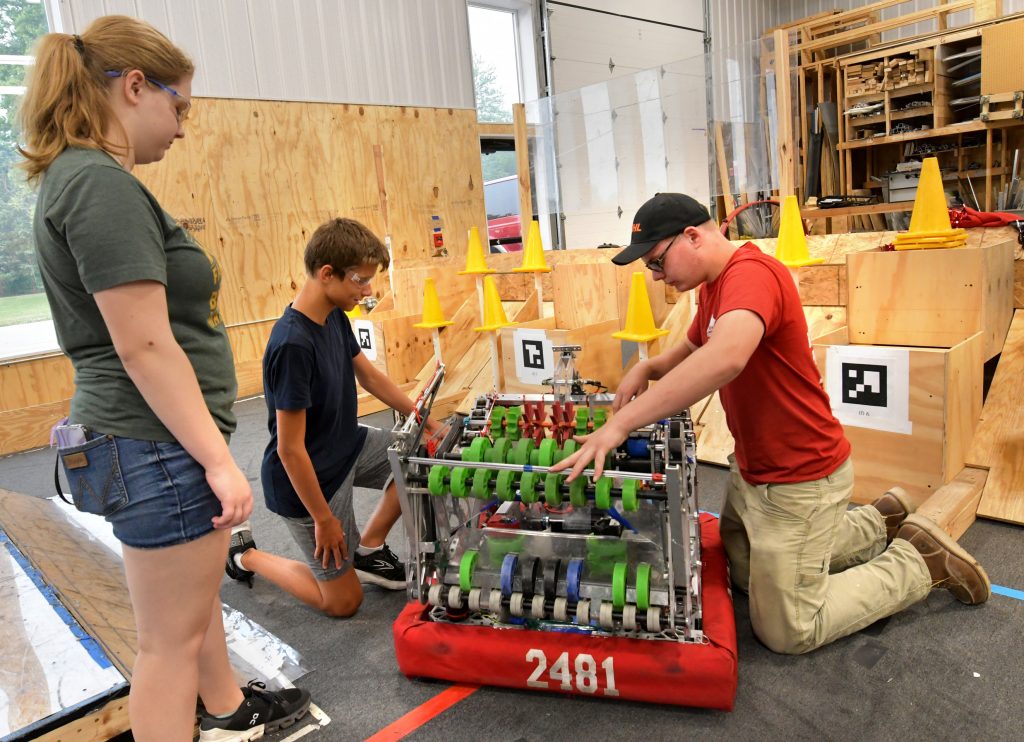Robotics competitions have taken off in central Illinois schools
If you think those school robotics tournaments you’ve heard about in recent years are a passing fad, you might want to consider the spanking new robotics center built adjacent to Tremont Grade School.
The 6,200-square-foot building, completed last year, holds banners that the Tremont High School robotics squad has accumulated over the years. They take their robotics seriously in Tremont: Team 2481 has qualified for the national finals every year since 2013, said Ben Martin, one of the team’s mentors who’s been involved in the First Robotics program for 20 years, starting as a high school student in Indianapolis.

Now a strategy manager for Caterpillar Inc., Martin pointed to plaques on the wall that credit sponsors like the Caterpillar Foundation and Precision Planting and over 60 volunteers that made the building possible.
The building holds something else: equipment such as a CNC router, computers, lathe, milling machines, drill press and a variety of saws. There are also machines that the students built, each with a story to tell.
From Segway to central Illinois
Welcome to the world of First Robotics, a program conceived by Dean Kamen, inventor of the Segway human transporter, who wanted to give math and science students a sport of their own. The thing caught on.
This year, some 3,300 high school teams from 31 countries took part in competition using industrial-size robots that students have built and operate. With the aid of dedicated mentors, the kids do it all: programming, electrical work, construction, even public relations.
Competitions at the local, regional and national levels have teams battling head to head, with the teens often winding up helping their opponents. The unique nature of the matches involves team partnerships that add another dimension to the competition, said Martin.
“We’re in the off-season now,” said Martin on a summer day inside the Tremont robotics building, which drew 250 people for an open house. There will be occasional activity as informational meetings are held for students interested in the program, but the first off-season competition will be the Robot Rumble, an annual event at Tremont High School that will involve 32 teams on Oct. 28.
The real fun starts in January when the Robotics First plans come down for teams to study. “We spend January and February building our robot to compete in several competitions,” said Martin, estimating the Tremont team will number about 28 kids.
Andrew Kunz, a 16-year-old student at Morton High School and a member of the Tremont team, got his robotic indoctrination with the Lego League, a competition open to grade schoolers. “It’s a lot of fun to build a robot, see it compete and learn from your mistakes,” he said.
Another Tremont team member, Luke Tucker, a 14-year-old homeschooler, sized up the program succinctly: “You learn practical skills for later in life in a fun environment.”
With kids from East Peoria, Morton, Pekin and Mackinaw, the Tremont team involves students from throughout the area. “If a student wants to participate in robots, we’re open to it,” said Martin.
The competition intensifies
Tremont isn’t the only robotic powerhouse in central Illinois. “Competition here is escalating,” said Martin. Area teams with names like Robot Casserole and Icarus compete along with squads from Limestone, Washington and Metamora.
While Matt Draear serves as coach of the Tremont team, Brian Stoecker, an engineering teacher at Metamora Township High School, coaches a team that’s been competing for 12 years. Up to 47 students have participated.
“Usually, we have around 40 on the team,” said Stoecker. “I think kids are starting to see the benefits of the program,” he said.
The Metamora squad breaks into teams to work on different aspects of the project in preparing for a competition, said Stoecker. “One team might focus on the chassis and drive train, another on the arm or claw. We also have a team that deals with media and the business side, such as going after sponsorships.”
Like Martin, Stoecker credited experienced mentors such as Ryan Shoff for helping students work on the project each year.
Preparing for the robotics competition can take up a lot of time, said Stoecker so efforts are made to ensure kids don’t get overloaded. “Some teams meet right after school. Others meet later. We try to make sure that kids get days off,” he said.
Having played high school sports himself, Stoecker feels athletics definitely help develop an individual. “But there’s a different atmosphere here,” he said of the First Robotics program. “You have to work well with the other team. It’s important to be cordial with everyone involved because the team you’re playing against one day may be your partner the next.”
The robotics program is also something for a student to put on his or her résumé, said Stoecker. “Metamora’s a big athletic school but how many pro athletes do we develop? First Robotics has a great record in turning out people that become engineers,” he said.
Katie Hunt, 18, spent four years on the Metamora robotics team but wasn’t involved in constructing a robot. Instead, she helped set up an outreach program for the team using social media. She’ll be attending the University of Missouri in the fall.
“My brother was on the (Metamora) team before me and I started attending competitions,” she said. “I was hooked. Everyone’s working together.”





